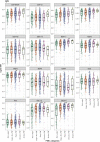Associations between prenatal malaria exposure, maternal antibodies at birth, and malaria susceptibility during the first year of life in Burkina Faso
- PMID: 37754682
- PMCID: PMC10580994
- DOI: 10.1128/iai.00268-23
Associations between prenatal malaria exposure, maternal antibodies at birth, and malaria susceptibility during the first year of life in Burkina Faso
Abstract
In this study, we investigated how different categories of prenatal malaria exposure (PME) influence levels of maternal antibodies in cord blood samples and the subsequent risk of malaria in early childhood in a birth cohort study (N = 661) nested within the COSMIC clinical trial (NCT01941264) in Burkina Faso. Plasmodium falciparum infections during pregnancy and infants' clinical malaria episodes detected during the first year of life were recorded. The levels of maternal IgG and IgG1-4 to 15 P. falciparum antigens were measured in cord blood by quantitative suspension array technology. Results showed a significant variation in the magnitude of maternal antibody levels in cord blood, depending on the PME category, with past placental malaria (PM) more frequently associated with significant increases of IgG and/or subclass levels across three groups of antigens defined as pre-erythrocytic, erythrocytic, and markers of PM, as compared to those from the cord of non-exposed control infants. High levels of antibodies to certain erythrocytic antigens (i.e., IgG to EBA140 and EBA175, IgG1 to EBA175 and MSP142, and IgG3 to EBA140 and MSP5) were independent predictors of protection from clinical malaria during the first year of life. By contrast, high levels of IgG, IgG1, and IgG2 to the VAR2CSA DBL1-2 and IgG4 to DBL3-4 were significantly associated with an increased risk of clinical malaria. These findings indicate that PME categories have different effects on the levels of maternal-derived antibodies to malaria antigens in children at birth, and this might drive heterogeneity to clinical malaria susceptibility in early childhood.
Keywords: Plasmodium falciparum; childhood; cord blood; malaria; maternal antibodies; pregnancy; prenatal exposure; protection.
Conflict of interest statement
The authors declare no conflict of interest.
Figures




References
-
- Asante KP, Owusu-Agyei S, Cairns M, Dodoo D, Boamah EA, Gyasi R, Adjei G, Gyan B, Agyeman-Budu A, Dodoo T, Mahama E, Amoako N, Dosoo DK, Koram K, Greenwood B, Chandramohan D. 2013. Placental malaria and the risk of malaria in infants in a high malaria transmission area in Ghana: a prospective cohort study. J Infect Dis 208:1504–1513. doi: 10.1093/infdis/jit366 - DOI - PMC - PubMed
-
- Natama HM, Rovira-Vallbona E, Somé MA, Zango SH, Sorgho H, Guetens P, Coulibaly-Traoré M, Valea I, Mens PF, Schallig HDFH, Kestens L, Tinto H, Rosanas-Urgell A. 2018. Malaria incidence and prevalence during the first year of life in Nanoro, Burkina Faso: a birth cohort study. Malar J 17:163. doi: 10.1186/s12936-018-2315-4 - DOI - PMC - PubMed
-
- Le Port A, Watier L, Cottrell G, Ouédraogo S, Dechavanne C, Pierrat C, Rachas A, Bouscaillou J, Bouraima A, Massougbodji A, Fayomi B, Thiébaut A, Chandre F, Migot-Nabias F, Martin-Prevel Y, Garcia A, Cot M. 2011. Infections in infants during the first 12 months of life: role of placental malaria and environmental factors. PLoS One 6:e27516. doi: 10.1371/journal.pone.0027516 - DOI - PMC - PubMed
-
- Riley EM, Wagner GE, Ofori MF, Wheeler JG, Akanmori BD, Tetteh K, McGuinness D, Bennett S, Nkrumah FK, Anders RF, Koram KA. 2000. Lack of association between maternal antibody and protection of African infants from malaria infection. Infect Immun 68:5856–5863. doi: 10.1128/IAI.68.10.5856-5863.2000 - DOI - PMC - PubMed
MeSH terms
Substances
Associated data
LinkOut - more resources
Full Text Sources
Medical
Research Materials
Miscellaneous

